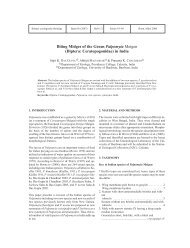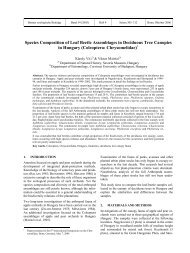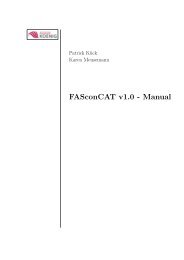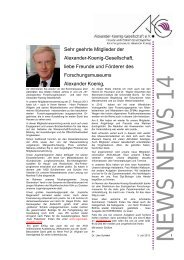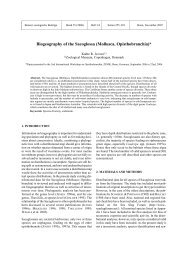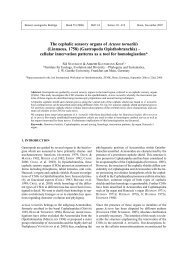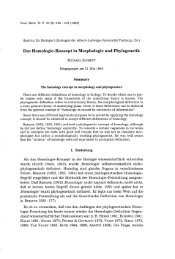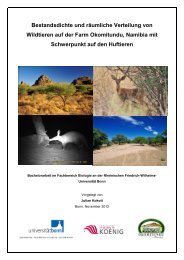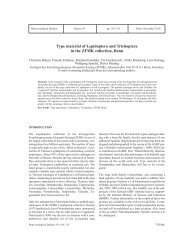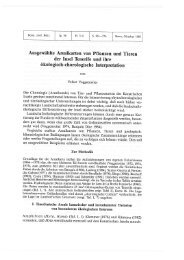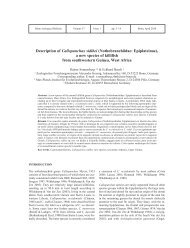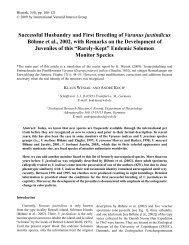Islands Between the Realms: A Revised Checklist of the ...
Islands Between the Realms: A Revised Checklist of the ...
Islands Between the Realms: A Revised Checklist of the ...
You also want an ePaper? Increase the reach of your titles
YUMPU automatically turns print PDFs into web optimized ePapers that Google loves.
114 André KOCH et al.: A <strong>Revised</strong> <strong>Checklist</strong> <strong>of</strong> <strong>the</strong> Herpet<strong>of</strong>auna <strong>of</strong> <strong>the</strong> Talaud Archipelago, Indonesia<br />
Additional material: ZMA 15942 (1 spec.), Gunung<br />
Doeata (= Mt. Doata), Karakelong, coll. H. J. LAM<br />
1926; ZMA 17884 (1 spec.), same data as previous<br />
specimen.<br />
Distribution: DE JONG (1928) reported one specimen (but<br />
see ‘additional material’) <strong>of</strong> C. marmoratus from Karakelong<br />
Island. However, BRONGERSMA (1934) showed that<br />
Sulawesi specimens <strong>of</strong> C. marmoratus were referable to<br />
C. fumosus. Accordingly, ISKANDAR & NIO (1996) doubted<br />
<strong>the</strong> occurrence <strong>of</strong> C. marmoratus on Sulawesi as previously<br />
mentioned (e.g., DE ROOIJ 1915). This is <strong>the</strong> first<br />
record <strong>of</strong> C. cf. jellesmae for Salibabu Island and <strong>the</strong><br />
nor<strong>the</strong>rnmost occurrence <strong>of</strong> <strong>the</strong> entire range <strong>of</strong> this species.<br />
Fig. 8.<br />
Koch.<br />
Hydrosaurus sp. from Salibabu Island. Photo by André<br />
Ecology: Both voucher specimens, apparently a female<br />
and a male (<strong>the</strong> female carrying two well-developed eggs<br />
which are visible through <strong>the</strong> thin skin), were found at<br />
20.30 p.m. at low elevations on <strong>the</strong> trunks <strong>of</strong> a tree and a<br />
coconut palm, respectively.<br />
with six groups <strong>of</strong> two to six tubercular, carinate scales;<br />
three fur<strong>the</strong>r such enlarged scales along <strong>the</strong> side <strong>of</strong> <strong>the</strong><br />
neck; towards <strong>the</strong> ventral side numerous enlarged, smooth<br />
scales arranged in more or less distinct transverse rows;<br />
ventral scales homogenous, smooth; subdigitals under<br />
fourth toe small at basis, followed by 35 relatively enlarged<br />
subdigitals after first phalanx; toes laterally with a<br />
row <strong>of</strong> extremely wide (up to 1.9 mm) scales, 36 at fourth<br />
toe forming a serrated edge. Ten and eleven femoral pores,<br />
respectively. Ground color green to brownish with enlarged<br />
scales <strong>of</strong> <strong>the</strong> dorsal and lateral side being lighter;<br />
ventral side whitish, throat darker.<br />
Taxonomy: Phenetically, <strong>the</strong> Talaud specimen resembles<br />
a juvenile H. pustulatus from Panay Island, central Philippines,<br />
in color pattern and scalation (photo courtesy <strong>of</strong> M.<br />
Gaulke). However, a systematic assignment <strong>of</strong> <strong>the</strong> Talaud<br />
population ei<strong>the</strong>r to H. amboinensis from Sulawesi, H.<br />
pustulatus from <strong>the</strong> Philippines, H. weberi from Halmahera<br />
or to ano<strong>the</strong>r hi<strong>the</strong>rto unrecognized taxon seems premature<br />
at this time, due to <strong>the</strong> lack <strong>of</strong> diagnostic characters<br />
(dorsal and nuchal crests, adult color pattern) in <strong>the</strong><br />
juvenile voucher specimen and insufficient material for<br />
comparison <strong>of</strong> <strong>the</strong> three Hydrosaurus taxa currently recognized.<br />
Gekkonidae<br />
Cyrtodactylus cf. jellesmae (Boulenger, 1897)<br />
Material examined: MZB Lac. 5126 (AK056), MZB<br />
Lac. 5128 (AK055).<br />
Morphology: Both sexes lack preanal and femoral pores<br />
and <strong>the</strong> ear openings are oval as characteristic for C. jellesmae<br />
(BOULENGER 1897; DE ROOIJ 1915). Lateral fold present<br />
between axilla and groin. However, in coloration and<br />
scalation <strong>the</strong> Salibabu population differs from those <strong>of</strong><br />
Sangihe Island and north Sulawesi. The characteristic<br />
dark, V- and M-shaped dorsal markings are less distinct<br />
and <strong>the</strong> tubercles have light tips only laterally. In addition,<br />
<strong>the</strong> Talaud population shows less pronounced tubercles on<br />
dorsum, legs and tail. From <strong>the</strong> new described species, C.<br />
wallacei, <strong>the</strong> Talaud geckos are distinguished by <strong>the</strong> absence<br />
<strong>of</strong> enlarged subcaudal scales (HAYDEN et al. 2008).<br />
Taxonomy: Probably DE JONG’s (1928) specimen from <strong>the</strong><br />
Talaud <strong>Islands</strong> will prove to belong to C. cf. jellesmae<br />
which was frequently found on Sulawesi and adjacent islands<br />
compared to C. fumosus and C. wallacei (unpubl.<br />
data). Future molecular studies are required to enlighten<br />
<strong>the</strong> systematics and taxonomy <strong>of</strong> this morphologically<br />
cryptic complex <strong>of</strong> gecko species in <strong>the</strong> Sulawesi region.<br />
Gehyra mutilata (Wiegmann, 1834)<br />
Material examined: MZB Lac. 5124 (AK046).<br />
Distribution: Gehyra mutilata is herein reported for <strong>the</strong><br />
first time for <strong>the</strong> Talaud <strong>Islands</strong>. This invasive gecko<br />
species inhabits Sou<strong>the</strong>ast Asia, Oceania, Madagascar,<br />
Mexico, California, Hawaii, and New Zealand. It was<br />
probably accidentally introduced from <strong>the</strong> Philippines or<br />
North Sulawesi by human transportation.




